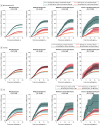Hearing Loss, Incident Parkinson Disease, and Treatment With Hearing Aids
- PMID: 39432289
- PMCID: PMC11581660
- DOI: 10.1001/jamaneurol.2024.3568
Hearing Loss, Incident Parkinson Disease, and Treatment With Hearing Aids
Abstract
Importance: The risk of developing Parkinson disease (PD) after objective hearing loss is unknown. PD studies using self-reported hearing loss are insensitive, and objective data are lacking.
Objective: To examine the association of hearing loss with incident PD in US veterans and its effect modification by well-established prodromal conditions and hearing aids.
Design, setting, and participants: This cohort study analyzed electronic health record data from the US Department of Veterans Affairs for veterans who had an audiogram from January 1, 1999, to December 30, 2022. Individuals with data missing or a preexisting PD diagnosis were excluded.
Exposure: Audiogram-confirmed hearing loss.
Main outcomes and measures: Cumulative incidence of PD was calculated with adjustment for competing risk of death.
Results: Among 7 296 051 veterans with an audiogram, 3 596 365 were included. They were mostly male (n = 3 452 898 [96%]) and had a mean (SD) age of 67 (10.3) years. A total of 750 010 individuals (20.8%) had normal hearing at the time of audiometry examination; among those with hearing loss, 1 080 651 (30.0%), 1 039 785 (28.9%), 568 296 (15.8%), and 157 623 (4.3%) individuals had mild (20-<35 dB), moderate (35-<50 dB), moderate to severe (50-<65 dB), and severe to profound (65-120 dB) hearing loss, respectively. Age, gender, and smoking history were balanced between all exposed and unexposed groups with further adjustment for race, ethnicity, and frailty. At 10 years after the baseline audiogram, the numbers of additional cases of PD were 6.1 (95% CI, 4.5-7.79, 15.8 (95% CI, 12.8-18.8), 16.2 (95% CI, 11.9-20.6), and 12.1 (95% CI, 4.5-19.6) among veterans with mild, moderate, moderate to severe, and severe to profound hearing loss, respectively, compared with those with normal hearing. When combined with established prodromal conditions, hearing loss was associated with 5.7 (95% CI, 2.2-9.2) additional cases of PD at 10 years compared with either condition alone. With prompt hearing aid dispensation, incident cases of PD decreased by 21.6 cases (95% CI, 19.5-23.6) at 10 years.
Conclusions and relevance: Hearing loss appears to be an independent risk factor for later development of PD. Hearing aids attenuate this risk, and therefore widespread screening for hearing loss and appropriate use of hearing aids may reduce the incidence of PD. Additional studies are needed to examine the mechanisms underlying the association between hearing loss and PD.
Conflict of interest statement
Figures




References
MeSH terms
Grants and funding
LinkOut - more resources
Full Text Sources
Medical
Miscellaneous

